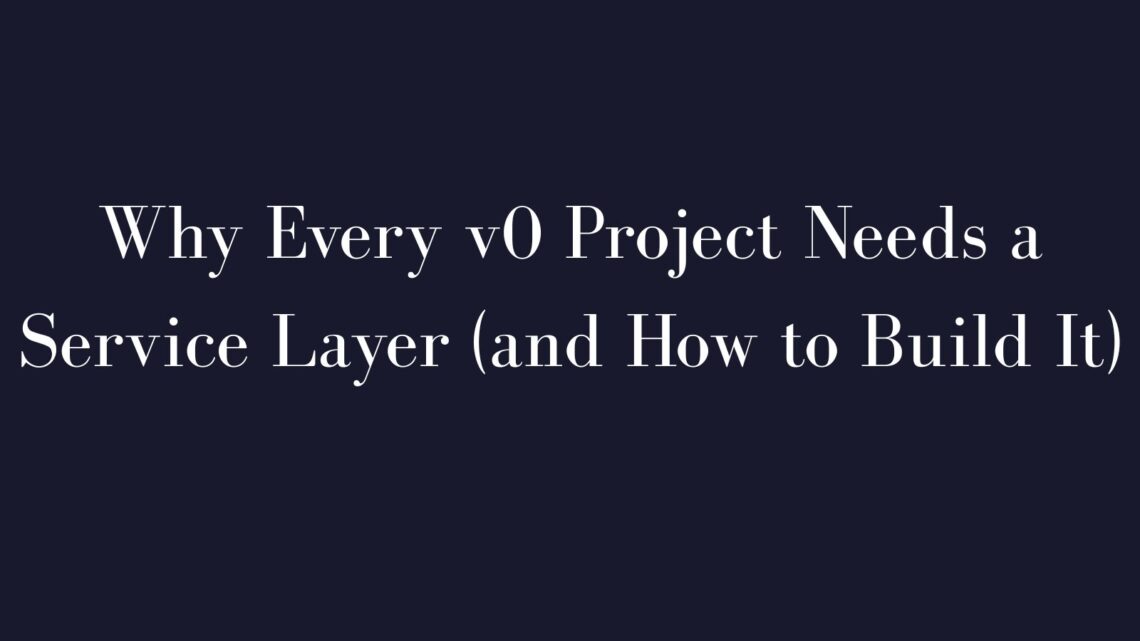A service layer adds a vital architectural boundary in v0 projects, separating backend logic from frontend UI. This separation is essential for scalability, maintainability, and testability, especially when using AI-powered tools like Vercel’s v0 to generate the frontend.
The Necessity and Benefits of Implementing a Service Layer in Vercel v0 Projects (2025)
A service layer brings:
- Separation of concerns: frontend teams focus on UI; backend teams manage logic and data.
- Maintainability: backend changes don’t affect frontend contracts.
- Testability: isolate logic for unit, integration, and E2E testing.
- Reusability: share logic across components or apps.
- Performance & scale: scale Vercel Functions independently.
- API integration: cleanly connect to third-party services.
Architectural Considerations for Incorporating a Service Layer into v0 Projects
When designing your service layer:
- Go API-First: design your API before frontend implementation.
- Define boundaries: group functions by domain (e.g. users, products).
- Choose protocols: REST and GraphQL are most common.
- Use DTOs: enforce data contracts between frontend and backend.
- Handle errors gracefully: return frontend-safe error messages.
- Secure endpoints: integrate with tools like Supabase for auth.
Practical Implementation of a Service Layer in v0 Projects
Suggested folder structure:
├── frontend/ # v0-generated UI (Next.js)
├── service-layer/
│ ├── functions/ # Vercel Functions (per resource)
│ ├── lib/ # helpers, validators
│ ├── data/ # DB connectors, ORMs
├── vercel.json
├── package.jsonExample Vercel Function:
// service-layer/functions/users/route.ts
import { NextResponse } from 'next/server';
export async function GET() {
try {
const users = await getUsersFromDB();
return NextResponse.json({ users });
} catch (err) {
console.error(err);
return new NextResponse('Server error', { status: 500 });
}
}Best practices:
- Keep functions focused.
- Use TypeScript for safety.
- Validate all input.
- Store secrets in Vercel env vars.
- Use Fluid Compute for scale.
Strategies and Methods for Testing the Functionality of a Service Layer in v0 Projects
- Unit testing: test functions in isolation (Jest, Mocha).
- Integration testing: check DB/service connections.
- E2E testing: simulate user flow (Playwright, Cypress).
- API testing: use Postman/Insomnia to hit endpoints.
- Preview deployments: use Vercel preview to test live merges.
Leveraging Libraries, Tools, and Vercel Features for Building and Managing the Service Layer
- Vercel Functions: core building block.
- Vercel Integrations: plug into Supabase, Neon, MongoDB.
- Vercel CLI: deploy/manage services fast.
- Environment Variables: keep credentials safe.
- Monitoring: use Vercel logging to catch bugs early.
- Helpful libs: express, zod, Prisma, next/server.
Common Challenges and Solutions When Implementing a Service Layer in v0 Projects
| Challenge | Solution |
|---|---|
| Extra complexity | Clear boundaries + docs |
| Added latency | Optimize payloads + use Edge Functions |
| Frontend/backend mismatch | Define contracts with DTOs |
| State syncing | Use SWR/tRPC or central stores |
| Debugging multi-layered | Use Vercel logging, structured error returns |
Step-by-Step Guide: Adding a Service Layer to a v0 Project (2025)
For new projects:
- Plan your architecture (API-First).
- Generate the frontend with v0.
- Create a
/service-layerfolder. - Build APIs using Vercel Functions.
- Connect to a database in
/data. - Fetch data in frontend using fetch/axios.
- Test each layer: unit, integration, E2E.
- Deploy to Vercel.
For existing projects:
- Review current architecture.
- Identify backend logic in UI code.
- Create
/service-layerwithfunctions,data, andlib. - Move and refactor backend logic.
- Replace old logic with API calls.
- Test and refactor for performance.
- Deploy with updated config.
Conclusion: Best Practices and Future Trends for Service Layers in Vercel v0 Development
Using a service layer in 2025 is no longer optional for scalable v0 projects. It enhances clarity, modularity, and test coverage. Best practices include defining contracts, isolating logic, testing thoroughly, and using serverless platforms like Vercel Functions. Expect AI to increasingly assist in backend scaffolding, complementing tools like v0 on the frontend.
FAQ
What is a service layer in software architecture?
A service layer is an abstraction that separates frontend/UI logic from backend operations like data access and business rules.
Does Vercel v0 support backend development?
Not directly—v0 focuses on frontend. Backend logic should be handled via Vercel Functions in a separate layer.
What’s the benefit of an API-first approach in v0?
It helps decouple frontend and backend development, improves scalability, and ensures consistent data contracts.
How do I connect Supabase to my v0 project?
Use Vercel Integrations or install the Supabase client in your service layer and connect via environment variables.
You May Need To Read:





